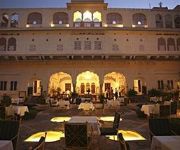Facts and Data
Webpages:
Official Unesco Page
Portal to the Heritage of Astronomy
Basis Data:
Unesco World heritage since: 2010
Size of heritage: 1.87 ha
- Buffer zone: 15 ha
Coordinates:
Longitude: 75,825°
Latitude: 26,925°
Summary
The Jantar Mantar, in Jaipur, is an astronomical observation site built in the early 18th century. It includes a set of some 20 main fixed instruments. They are monumental examples in masonry of known instruments but which in many cases have specific characteristics of their own. Designed for the observation of astronomical positions with the naked eye, they embody several architectural and instrumental innovations. This is the most significant, most comprehensive, and the best preserved of India's historic observatories. It is an expression of the astronomical skills and cosmological concepts of the court of a scholarly prince at the end of the Mughal period.
Location on Map
Show bigger map on Openstreetmap
The Jantar Mantar, Jaipur
The Jantar Mantar, located in Jaipur, India, is a UNESCO World Heritage site that holds immense historical and scientific significance. Built in the early 18th century by Maharaja Sawai Jai Singh II, this astronomical observatory stands as a testament to India's rich scientific heritage.
History
Maharaja Sawai Jai Singh II, a keen astronomer and mathematician, commissioned the construction of the Jantar Mantar in 1724. Inspired by the works of renowned astronomers and mathematicians like Ulugh Beg and Ptolemy, Jai Singh aimed to create a state-of-the-art observatory that would aid in accurate astronomical observations and calculations.
The Jantar Mantar in Jaipur is one of five such observatories built by Jai Singh across India. Each observatory was strategically located in different cities to ensure accurate measurements from various latitudes. The Jantar Mantar in Jaipur, being the largest and most well-preserved, is considered the crown jewel of Jai Singh's astronomical legacy.
Architecture and Instruments
The Jantar Mantar is a remarkable example of architectural brilliance and scientific precision. Spread over an area of 18,700 square meters, it features a collection of 19 astronomical instruments, each serving a specific purpose.
One of the most prominent instruments is the Samrat Yantra, also known as the Giant Sundial. Standing at a height of 27 meters, it is the world's largest sundial and can accurately measure time to within two seconds. The Samrat Yantra's shadow moves at a speed of approximately one millimeter per second, allowing for precise timekeeping.
Another notable instrument is the Jai Prakash Yantra, a pair of hemispherical structures with markings that enable the observation of celestial bodies. It is particularly useful for measuring the altitude and azimuth of stars and planets.
Current State
The Jantar Mantar, Jaipur, continues to be a significant scientific and cultural landmark. It attracts visitors from around the world who are fascinated by its architectural grandeur and scientific ingenuity.
Efforts have been made to preserve and maintain the site, ensuring that its historical and scientific value remains intact. The instruments have undergone restoration to ensure their accuracy and functionality. The site also serves as an educational hub, hosting workshops and lectures on astronomy and the history of the Jantar Mantar.
Recognizing its importance, the Jantar Mantar, Jaipur, was inscribed as a UNESCO World Heritage site in 2010. This recognition has further elevated its status and brought attention to its historical and scientific significance.
Visiting the Jantar Mantar, Jaipur, is a truly awe-inspiring experience. It allows visitors to step back in time and marvel at the scientific achievements of the past. The site serves as a reminder of India's rich scientific heritage and the contributions made by visionaries like Maharaja Sawai Jai Singh II.
As a UNESCO World Heritage site, the Jantar Mantar, Jaipur, stands as a testament to the importance of preserving and celebrating our scientific and cultural heritage for generations to come.
Hotels and places to stay
Raj Palace
The Gold Palace & Resorts
Golden Tulip Jaipur
Samode Haveli
Rajputana Haveli
Comfort Inn Sapphire
Khatu Haveli
The Wall Street- A Business Hotel
Comfort Inn Sapphire
Hotel Savoy
Videos from the area
Videos provided by Youtube are under the copyright of their owners.

















